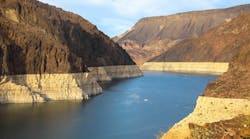Are Ants and Termites Nibbling Their Way into MS4 Program Pocketbooks?
About the author:
Jacqueline McMillen is a registered professional civil engineer and qualified industrial stormwater practitioner trainer of record with NV5 Engineering. McMillen can be reached at [email protected]
In June 2017, the California Regional Water Quality Control Board and the Central Valley Region (Central Valley RWQCB) adopted a Basin Plan Amendment for the Sacramento River and San Joaquin River Basins for the control of pyrethroid pesticide discharges. The amendment establishes controls for pyrethroid discharges, including prohibition of discharges of pyrethroid pesticides above certain concentrations, total maximum daily loads (TMDLs) for pyrethroid pesticides, recommendations for agency regulation of pyrethroids and potential monitoring requirements.
Synthetic pyrethroids are the most common forms of commercially available urban pesticides for ants, termites and flying insects currently being used as a result of the shift from historical bans of previously used DDT, Chlorpyrifos and Diazinon pesticides for non-agricultural uses. They are also often used in California on fruit and nut trees, row crops, rice, nursery and urban landscapes. The California Department of Pesticide Regulation (DPR) tracks trends in pesticide use and has shown an increase in the use of pyrethroids for certain crops, including almonds, tomatoes and grapes. In 2017, the latest year that data is available from DPR, pyrethroids were utilized on 16% more acreage for almonds, 17% more acreage for tomatoes, and 30% more acreage for grapes. Pesticide drift during application and surface water runoff can result in contamination and subsequent sediment accumulation in adjacent waterways. Pyrethroids tend to be hydrophobic and have low solubility in water. They have a high affinity for soil and are sorbed strongly to the sediments of natural water systems.
As a result of their current use and their extreme effectiveness on target organisms, municipal urban and agricultural runoff has resulted in elevated toxicity in downstream receiving waters. Because pyrethroid pesticides are widely employed for pest control throughout urban and residential areas, pyrethroids have been found at levels of concern in lakes, rivers and streams in the San Joaquin and Sacramento River Basins that received runoff from urban and agricultural land uses. In order to address the identified surface water impairments, the Central Valley RWQCB has recently required Municipal Separate Storm Sewer System (MS4) Permittees in the affected watersheds to manage pyrethroid pesticide discharges from urban MS4 outfalls by issuing an order pursuant to California Water Code Section 13383. Section 13383 allows the state or a regional board to establish monitoring and reporting requirements for any dischargers to navigable waters. In 2020, MS4 Permittees throughout the Sacramento and San Joaquin River Basins received a Central Valley RWQCB order to either develop and implement a Baseline Monitoring Plan or a Pyrethroid Management Plan. Ultimately, permittees may choose their preferred path in order to comply with the order. There are advantages and disadvantages to both approaches, and the best course of action will vary for each municipality.
Baseline Monitoring Plan
The intent of a baseline monitoring program is to determine whether discharges from a given permittee’s jurisdiction show exceedances of pyrethroid pesticide water quality standards in the receiving waters downstream. In order to implement a monitoring program, MS4 Permittees in the Sacramento and San Joaquin River Basins can choose to develop a Baseline Monitoring Plan, which shall include a Surface Water Ambient Monitoring Program (SWAMP) Comparable Quality Assurance Program Plan (QAPP). The Baseline Monitoring Plan and QAPP should describe the program goals, monitoring locations, sampling methods, data quality objectives, laboratory methods and detection limits, and other pertinent data to guide the baseline monitoring.
Should a MS4 permittee choose to perform baseline monitoring, multiple wet weather sampling events and at least one dry weather event will likely be required. For example, the CVRWQB Letter states that receiving water or MS4 Discharge monitoring should be conducted four times per year, including three wet weather events (i.e. post first flush, post mid-winter, post spring runoff) and one dry weather event. Additionally, water column and sediment toxicity monitoring should be performed four times per year to coincide with pyrethroid chemistry and organic carbon receiving water monitoring events.
While some municipalities may have the staff and technical expertise to perform baseline monitoring using their own in-house personnel, many cities lack the resources to perform wet weather storm water sampling. Oftentimes, this type of labor-intensive field work must be contracted out, which may result in a greater expense to the city. Wet weather monitoring also carries the risk of false starts or predicted rain events, which may not materialize, which can add to the costs.
However, portions of the Sacramento and San Joaquin River basins are located in the mountains and foothills and are made up of largely rural communities. Some permittees, particularly those covered by the Phase II Small MS4 permit may have a small contribution, if any, to exceedances of water quality standards for pyrethroids. Due to the lack of dense urban areas, such communities may benefit long term from performing baseline monitoring if there is good cause to believe that monitoring will show that these permittees do not exceed pyrethroid pesticide standards. Such a demonstration would allow a permittee to forego development and implementation of a Pyrethroid Management Plan in the future. If baseline monitoring does show exceedances, a Pyrethroid Management Plan would still be required.
Pyrethoid Management Plan
In lieu of developing and implementing a Baseline Monitoring Plan, permittees may choose to move directly to development and implement a Pyrethroid Management Plan. Statewide studies, including a review of pyrethroid monitoring data from urban watersheds developed by the California Stormwater Quality Association (CASQA), have shown that municipal storm water is known to contain pyrethroids at levels exceeding the prohibition triggers established in the Central Valley RWQCB Basin Plan. By choosing to develop a Pyrethroid Management Plan, rather than perform baseline monitoring of wet and dry weather discharges, a permittee will acknowledge that “the existing data are assumed to be representative of their discharge”. Some municipalities may be uncomfortable with assuming responsibility for exceedances without evidence collected from baseline monitoring.
A Pyrethroid Management Plan must identify a set of management practices that may be reasonably expected to effectively reduce pyrethroid levels in MS4 discharges. Management practices for municipal storm water dischargers may include education and outreach activities, such as encouraging reduced and proper pesticide use, reducing municipal runoff through implementation of Low Impact Development (LID), use of integrated pest management, and support of pollution prevention through the pesticide regulatory process. At this time, future trend monitoring and program effectiveness assessment is not explicitly required as part of a management plan, but it is possible that in the future some type of monitoring to demonstrate improvements in pyrethroid levels in surfaces waters may be required.
If a permittee suspects that their municipal discharges may be contributing to water quality standard excesses for pyrethroids, it is likely more economical to proceed directly to developing a management plan to address the use of pyrethroids for pest management. However, if historical water quality monitoring data is not available, particularly in rural areas, it will be difficult for permittees to assess their potential impacts to receiving waters or their program’s effectiveness.
Looking Outside the Central Valley
While the Central Valley RWQCB may be the most recent agency to issue orders to address pyrethroid pesticide exceedances of water quality standards, their prolific use for structural pest control within urban areas and for agricultural uses has resulted in impacts to watersheds throughout California, as has been seen historically with other pesticides. Municipalities can be proactive through implementation of integrative pest management that focuses on long-term prevention of pests or their damage through a combination of techniques, such as biological control, habitat manipulation and use of resistant plants, rather than use of chemical pesticides. The University of California Statewide Integrated Pest Management Program (UC IPM) is a useful resource for residents, growers, land managers, community leaders and other professional pest managers to learn how to prevent and solve pest problems with minimal unintended consequences. Pesticides can be used in a manner that protects human health and the environment when selected and applied appropriately only after ecosystem-based strategies have been considered.
SOURCES:
Central Valley Regional Water Quality Control Board. Proposed Amendments to the Water quality Control Plan for the Sacramento River and San Joaquin River Basin for the Control of Pyrethroid Pesticides Discharges Final Staff Report. June 2017.
Pulupa, Patrick. Patrick Pulupa to Jered Reinking. July 13, 2020. Order to Submit Technical and monitoring Reports Pursuant to California Water Code Sections 13267 and 13383.
UC Sustainable Agriculture Research and Education Program. 2017. "Integrated Pest Management (IPM)." What is Sustainable Agriculture? UC Division of Agriculture and Natural Resources.


